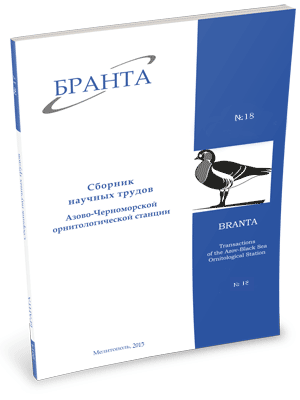
Transactions
of the Azov-Black Sea Ornithological Station



Avifauna of the oldest artificial Shatilov's wood in the Steppe Crimea and its historical changes
A. N. Tsvelykh
These ornithological studies were carried out in 2008-2010 in Shatilov's wood, an artificial insular forest planted in the middle of the 19th century in a very arid north-eastern part of the Crimea. Using the data of the 19th and 20th centuries, the avifauna changes were analysed for the whole period of the wood existence. In the 19th century the Shatilov's wood fauna was subjected to change at the expense of birds from neighbouring steppes, intrazonal habitats, and some forest species from the Mountain Crimea. During the 20th century the Shatilov's wood fauna was transformed mainly because of the invasion of bird species from forest areas of the Mountain Crimea. The Parus major and Sylvia atricapilla appeared there in the early 20th century, while Fringilla coelebs, Chloris chloris, Acanthis cannabina, Parus caeruleus, Luscinia megarhynchos, Caprimulgus europaeus, Cuculus canorus had inhabited the wood only by the mid 20th century. In the second half of the 20th century the Shatilov's wood fauna continued to change due to the forest species invaded from the Mountain Crimea and the adventive species which gradually expanded their range in the steppe zone by occupying areas of tree plantations, namely Asio otus, Columba palumbus, Streptopelia decaocto, Dendrocopos syriacus, Hippolais icterina, Coccothraustes coccothraustes.
Read the paper in a PDF fileReferences:
- Averin, Y. V. (1953). Harmful and useful vertebrates of treeshrub plantations of the steppe Crimea. Transactions of the Crimean branch of Academy of Sciences, USSR. Zoology, 3(3), 6–35. [in Russian]
- Dementyev, G.P., Gladkov, N.A., Ptushenko, E.S., Spangenberg, E.P., & Sudilovskaya, A.M. (1951). Birds of the Soviet Union. Moscow: ‘Sovetskaya Nauka’ Press, 1, 654. [in Russian]
- Kostin, Y. V. (1983). Birds of the Crimea. Moscow: ‘Nauka’ Press. [in Russian]
- Nikolsky, A. M. (1891). Vertebrates of the Crimea. Proceedings of the Imperial Academy of Sciences, 68 (4), 1–484. [in Russian]
- Radde, G. (1855). Animal life in the Sivash. Herald of Natural Sciences, (17), 523-540; 624-630. [in Russian].
- Tsvelykh, A. N. (2005). Expansion of the Syrian Woodpecker in the Crimea. Branta: Transactions of the Azov-Black Sea Ornithological Station, 8, 198–199. [in Russian].
- Tsvelykh, A. (2006). Elements of the Avifauna of the Mountain Crimea in Artificial Isolated Wood Areas of the Kerch Peninsula. Vestnik zoologii, 40(3), 241–248. [in Russian].
- Tsvelykh, A. N. (2011). Distribution of the Icterine Warbler Hippolais icterina (Vieill.) in the steppe zone of Left-bank Ukraine and its appearance in the Crimea. Branta: Transactions of the Azov-Black Sea Ornithological Station, 14, 63–67. [in Russian].
- Shatilov, I. N. (1874). Index of the ornithological collection of birds of Tavricheskaya Gubernia, donated to Zoological Museum of Moscow University by I.N.Shatilov. Proceedings of the Imperial Society of Nature and Anthropology Lovers, 10(2), 82–96. [in Russian]
- Pusanow, J. (1933). Versuch einer Revision der taurischen Ornis. Bulletin of Moscow Society for Nature Investigators. Biol. Depart, 42(1), 3–41. [in German]
- Schatiloff, J. (1860). Katalog meines Ornithologischen Museums der Vögel Tauriens, im Dorfe Schatilofka (Tamak) an der Mündung des Karasu ins faule Meer nebst einigen an Ort und Stelle gesammelten Notizen. Bulletin de la Société Imp. des Naturalistes de Moscou, 33(5), 488–518.